Analysis of Space Efficiency in High-Rise Timber Residential Towers
Abstract
:1. Introduction
2. Researching Space Efficiency in High-Rise Timber Residential Towers
- Environmental sustainability [54,55,56]: Timber, as a renewable and carbon-sequestering material, offers significant potential for reducing the carbon footprint of buildings. High-rise timber residential buildings have a lower embodied carbon footprint compared to traditional structures. Space efficiency studies in such buildings enable the quantification of the environmental benefits achieved through the optimized use of timber resources, including reduced energy consumption, greenhouse gas emissions, and resource depletion.
- Urban planning and density [57,58,59]: Urban areas face challenges related to population growth and limited land availability. High-rise timber buildings provide a sustainable solution by offering vertical density while minimizing land use. Space efficiency analyses help urban planners determine the optimal distribution of residential units within a building footprint, maximizing population density without compromising livability or architectural integrity. This approach considers factors such as building height, floor area ratio, and population density to inform urban development policies and strategies.
- Resource management [60,61,62]: Timber is known for its lightweight nature and low energy requirements during manufacturing and construction. Space efficiency studies in high-rise timber residential buildings focus on optimizing material usage, minimizing waste, and maximizing resource utilization. Scientific methods, such as life cycle assessments and material flow analyses, quantify the environmental impacts associated with different space configurations, guiding decision-making processes towards more sustainable construction practices.
- Human well-being and comfort [63,64,65]: Research in environmental psychology and building science emphasizes the importance of indoor environmental quality for occupants’ health and well-being. Space-efficient designs in high-rise timber buildings aim to enhance natural lighting, ventilation, and thermal comfort while promoting access to outdoor spaces and views. Scientific measurements, such as daylighting analysis, indoor air quality monitoring, and occupant satisfaction surveys, provide empirical evidence of the positive effects of space efficiency on human health, productivity, and satisfaction.
- Structural integrity and safety [66,67,68]: High-rise timber buildings must meet stringent structural requirements to ensure occupant safety and building resilience. Space efficiency studies consider structural design parameters, such as load-bearing capacity, lateral stability, and fire resistance, in conjunction with spatial layouts. Advanced computational modeling and simulation techniques, including finite element analysis and performance-based design, assess the structural performance of different space configurations under various loading and environmental conditions, informing design decisions and regulatory compliance.
- Economic viability [69,70,71]: Space efficiency directly impacts the economic feasibility and profitability of high-rise timber residential projects. Scientific cost–benefit analyses evaluate the financial implications of different space configurations, taking into account construction costs, operational expenses, rental income, and market demand. Optimization algorithms and decision support tools help developers and investors identify the most economically viable design solutions that maximize returns on investment while meeting sustainability objectives.
3. Research Method
- -
- Core arrangement impacting the configuration of vertical movement and the allocation of shafts.
- -
- Building form influencing sizes and pattern of the floor slabs.
- -
- Structural system influencing disposition and sizes of the load-bearing constituents.
- -
- Structural material affecting the proportions of the load-bearing members.
4. Results
4.1. Main Architectural Design Parameters: Core Planning and Building Form
4.2. Main Structural Design Parameters: Structural Material and Structural System
4.3. Space Efficiency in High-Rise Timber Residential Buildings
4.3.1. Interrelationship of Space Efficiency and Core Planning
4.3.2. Interrelationship of Space Efficiency and Building Form
4.3.3. Interrelationship of Space Efficiency and Structural System
4.3.4. Interrelationship of Space Efficiency and Structural Material
4.3.5. Interrelationship of Space Efficiency and Composite Structural Material Combinations
5. Discussion
- (1)
- Central cores were the predominant core arrangements, while peripheral configurations ranked as the other preferred alternative. Prismatic forms emerged as the most preferred selections.
- (2)
- The widespread utilization of timber as a building material was predominant, with amalgamations of timber and concrete following closely as the subsequent choice. Load-bearing systems were primarily defined by the application of shear-walled frames and shear-wall configurations.
- (3)
- The average space utilization within the examined cases was recorded at 83%, exhibiting variances ranging from 70% to 93% across different cases.
- (4)
- The average proportion of core area-to-GFA was calculated at 10%, demonstrating fluctuations within the range of 4% to 21% across diverse scenarios.
- (5)
- No notable distinction was observed in the effect of various core planning strategies on spatial efficiency when properly designed, and similar conclusions were drawn regarding building forms and structural materials.
6. Conclusions
Author Contributions
Funding
Institutional Review Board Statement
Informed Consent Statement
Data Availability Statement
Conflicts of Interest
Appendix A
| # | Building Name | Country | City | Height (Meters) | # of Stories | Completion Date |
|---|---|---|---|---|---|---|
| 1 | Ascent | United States | Milwaukee | 87 | 25 | 2022 |
| 2 | HAUT | Netherlands | Amsterdam | 73 | 22 | 2022 |
| 3 | De Karel Doorman | Netherlands | Rotterdam | 71 | 22 | 2012 |
| 4 | Roots Tower | Germany | Hamburg | 65 | 19 | UC |
| 5 | Brock Commons Tallwood House | Canada | Vancouver | 58 | 18 | 2017 |
| 6 | Hyperion | France | Bordeaux | 55 | 16 | 2021 |
| 7 | Rundeskogen Hus B | Norway | Sandnes | 55 | 16 | 2013 |
| 8 | Treet | Norway | Bergen | 49 | 14 | 2015 |
| 9 | Lighthouse Joensuu | Finland | Joensuu | 48 | 14 | 2019 |
| 10 | Cederhusen | Sweden | Stockholm | 44 | 13 | UC |
| 11 | Hoas Tuuliniitty | Finland | Espoo | 44 | 13 | 2021 |
| 12 | Tallwood 1 at District 56 | Canada | Victoria | 42 | 12 | UC |
| 13 | Origine | Canada | Quebec | 41 | 13 | 2017 |
| 14 | INTRO Residential Tower | United States | Cleveland | 40 | 9 | 2022 |
| 15 | Sensations | France | Strasbourg | 38 | 11 | 2019 |
| 16 | Rundeskogen Hus C | Norway | Sandnes | 38 | 11 | 2013 |
| 17 | Monterey | Australia | Brisbane | 37 | 12 | 2021 |
| 18 | Trafalgar Place | UK | London | 36 | 10 | 2015 |
| 19 | Aveo Bella Vista | Australia | Sydney | 36 | 11 | 2018 |
| 20 | Kringsja Studentby | Norway | Oslo | 34 | 10 | 2018 |
| 21 | Rundeskogen Hus A | Norway | Sandnes | 34 | 10 | 2012 |
| 22 | SKAIO | Germany | Heilbronn | 34 | 10 | 2019 |
| 23 | Dalston Works | UK | London | 34 | 10 | 2017 |
| 24 | The Cube Building | UK | London | 33 | 10 | 2015 |
| 25 | Forte | Australia | Melbourne | 32 | 10 | 2012 |
| 26 | Botanikern | Sweden | Uppsala | 31 | 9 | 2019 |
| 27 | Cenni di Cambiamento | Italy | Milan | 31 | 9 | 2013 |
| 28 | Kajstaden | Sweden | Vasteras | 31 | 9 | 2019 |
| 29 | Press House | UK | London | 31 | 9 | 2017 |
| 30 | Vallen | Sweden | Vaxjo | 31 | 9 | 2015 |
| 31 | Stadthaus | UK | London | 29 | 9 | 2009 |
| 32 | Carbon12 | United States | Portland | 29 | 8 | 2018 |
| 33 | Moholt 50/50 | Norway | Trondheim | 28 | 9 | 2016 |
| 34 | Arbora Condominium | Canada | Montreal | 27 | 8 | 2019 |
| 35 | DAS Kelo | Finland | Rovaniemi | 27 | 8 | 2019 |
| 36 | Docenten | Sweden | Vaxjo | 27 | 8 | 2018 |
| 37 | Dramsvegen | Norway | Tromso | 27 | 8 | 2017 |
| 38 | Frostaliden | Sweden | Skövde | 27 | 8 | 2018 |
| 39 | Highpoint Terrace | UK | London | 27 | 8 | 2017 |
| 40 | Jo & Joe | France | Gentilly | 27 | 8 | 2019 |
| 41 | Limnologen | Sweden | Vaxjo | 27 | 8 | 2014 |
| 42 | Maskinparken TRE | Norway | Trondheim | 27 | 8 | 2018 |
| 43 | Puukuokka Housing Block | Finland | Jyvaskyla | 27 | 8 | 2018 |
| 44 | Residences J. Ferry | France | Saint-Dié-des-Vosges | 27 | 8 | 2014 |
| 45 | Strandparken | Sweden | Stockholm | 27 | 8 | 2014 |
| 46 | The Gardens Macarthur | Australia | Sydney | 27 | 8 | 2018 |
| 47 | Trummens Strand | Sweden | Vaxjo | 27 | 8 | 2019 |
| 48 | Wood City Residential Buildings | Finland | Helsinki | 27 | 8 | 2018 |
| 49 | Lucien Cornil Student Residence | France | Marseille | 27 | 8 | 2017 |
| 50 | Pentagon I | Norway | As | 27 | 8 | 2013 |
| 51 | Bridport House | UK | London | 27 | 8 | 2010 |
Appendix B
| Building Name | Building Form | Core Type | Structural System | Structural Material | |
|---|---|---|---|---|---|
| 1 | Ascent | Prismatic | Central | Shear-walled frame | Composite (T + C) |
| 2 | HAUT | Free | Peripheral | Shear-walled frame | Composite (T + C) |
| 3 | De Karel Doorman | Prismatic | Peripheral | Shear-walled frame | Composite (T + C + S) |
| 4 | Roots Tower | Prismatic | Central | Shear-walled frame | Composite (T + C) |
| 5 | Brock Commons Tallwood House | Prismatic | Peripheral | Shear-walled frame | Composite (T + C) |
| 6 | Hyperion | Free | Central | Shear-walled frame | Composite (T + C + S) |
| 7 | Rundeskogen Hus B | Free | Central | Shear-walled frame | Composite (T + C) |
| 8 | Treet | Prismatic | Peripheral | Trussed tube | Timber |
| 9 | Lighthouse Joensuu | Prismatic | Central | Shear wall | Timber |
| 10 | Cederhusen | Prismatic | Central | Shear wall | Timber |
| 11 | Hoas Tuuliniitty | Prismatic | Peripheral | Shear wall | Timber |
| 12 | Tallwood 1 at District 56 | Prismatic | Central | Shear-trussed frame | Composite (T + S) |
| 13 | Origine | Free | Central | Shear wall | Timber |
| 14 | INTRO Residential Tower | Prismatic | Peripheral | Shear-walled frame | Composite (T + C) |
| 15 | Sensations | Free | Central | Shear-walled frame | Timber |
| 16 | Rundeskogen Hus C | Free | Central | Shear-walled frame | Composite (T + C) |
| 17 | Monterey | Free | Peripheral | Shear-walled frame | Composite (T + C + S) |
| 18 | Trafalgar Place | Prismatic | Peripheral | Shear wall | Timber |
| 19 | Aveo Bella Vista | Free | Central | Shear-walled frame | Composite (T + C) |
| 20 | Kringsja Studentby | Prismatic | Central | Shear-walled frame | Timber |
| 21 | Rundeskogen Hus A | Free | Central | Shear-walled frame | Composite (T + C) |
| 22 | SKAIO | Prismatic | Central | Shear-walled frame | Composite (T + C) |
| 23 | Dalston Works | Prismatic | Central | Shear wall | Timber |
| 24 | The Cube Building | Free | Central | Shear-walled frame | Composite (T + C + S) |
| 25 | Forte | Prismatic | Central | Shear wall | Timber |
| 26 | Botanikern | Prismatic | Peripheral | Shear-trussed frame | Timber |
| 27 | Cenni di Cambiamento | Free | Central | Shear wall | Timber |
| 28 | Kajstaden | Prismatic | Peripheral | Shear wall | Timber |
| 29 | Press House | Prismatic | Central | Shear-walled frame | Timber |
| 30 | Vallen | Prismatic | Central | Shear-walled frame | Composite (T + C) |
| 31 | Stadthaus | Prismatic | Central | Shear wall | Timber |
| 32 | Carbon12 | Prismatic | Central | Shear-trussed frame | Composite (T + S) |
| 33 | Moholt 50/50 | Prismatic | Central | Shear wall | Timber |
| 34 | Arbora Condominium | Prismatic | Peripheral | Shear-walled frame | Timber |
| 35 | DAS Kelo | Prismatic | Peripheral | Shear-walled frame | Timber |
| 36 | Docenten | Prismatic | Peripheral | Shear wall | Composite (T + C) |
| 37 | Dramsvegen | Prismatic | Peripheral | Shear wall | Composite (T + C) |
| 38 | Frostaliden | Prismatic | Central | Shear-walled frame | Composite (T + C) |
| 39 | Highpoint Terrace | Prismatic | Peripheral | Shear wall | Timber |
| 40 | Jo & Joe | Prismatic | Peripheral | Shear-walled frame | Composite (T + C) |
| 41 | Limnologen | Prismatic | Central | Shear wall | Composite (T + C + S) |
| 42 | Maskinparken TRE | Prismatic | Central | Shear wall | Timber |
| 43 | Puukuokka Housing Block | Prismatic | Central | Shear-walled frame | Timber |
| 44 | Residences J. Ferry | Prismatic | Peripheral | Shear-walled frame | Timber |
| 45 | Strandparken | Prismatic | Peripheral | Shear wall | Composite (T + S) |
| 46 | The Gardens Macarthur | Prismatic | Peripheral | Shear wall | Timber |
| 47 | Trummens Strand | Prismatic | Peripheral | Shear wall | Timber |
| 48 | Wood City Residential Buildings | Prismatic | Peripheral | Shear-walled frame | Timber |
| 49 | Lucien Cornil Student Residence | Prismatic | Peripheral | Shear-walled frame | Composite (T + C) |
| 50 | Pentagon I | Prismatic | Central | Shear wall | Timber |
| 51 | Bridport House | Prismatic | Peripheral | Shear wall | Timber |
Appendix C

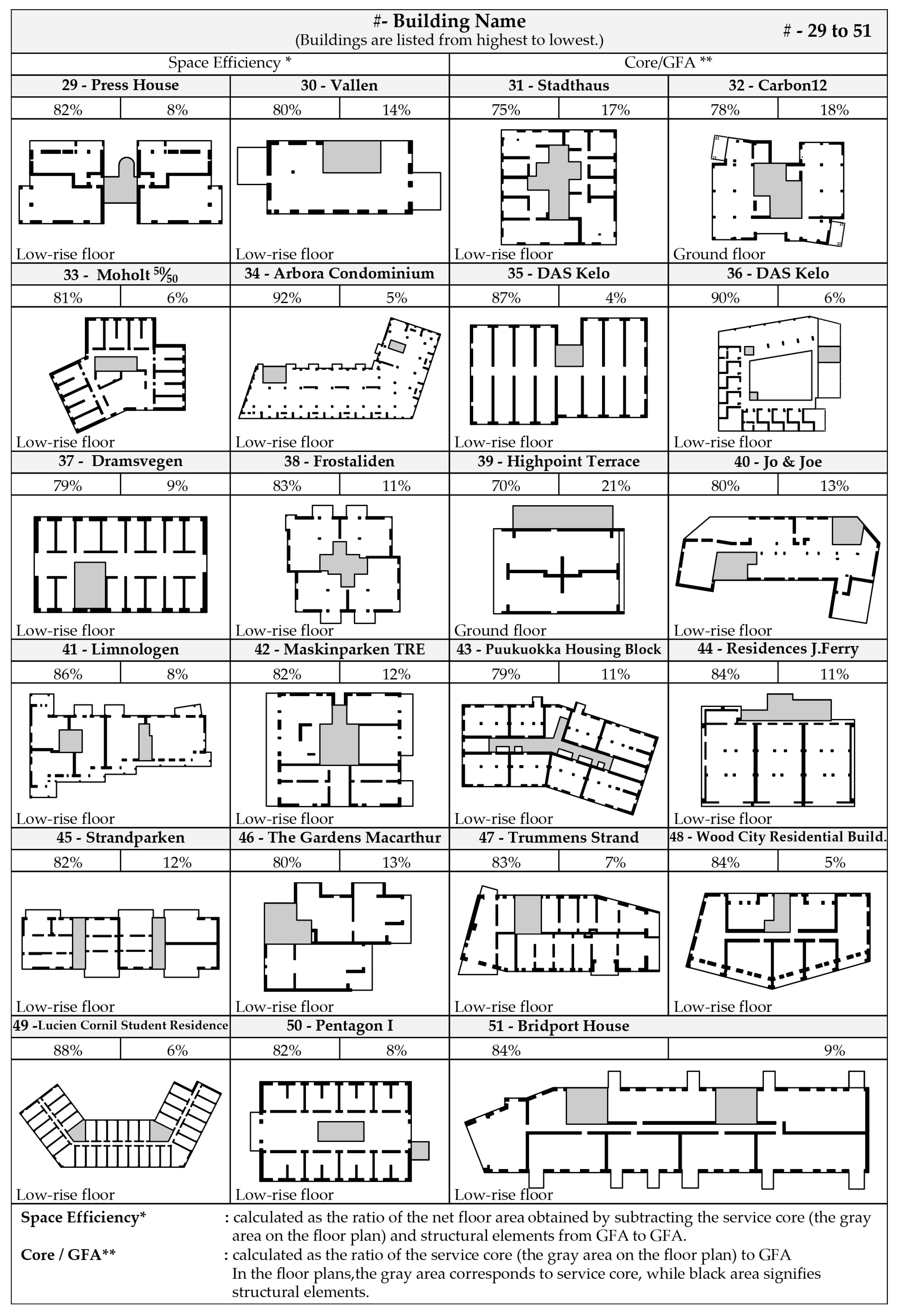
References
- Baiz, W.H.; Hoskara, E. Developing a measurement scale for sustainable high-rise building in city of Erbil. J. Asian Archit. Build. Eng. 2022, 21, 717–734. [Google Scholar] [CrossRef]
- United Nations. World Population Prospects—The 2017 Revision: Key Findings and Advance Tables; Department of Economic and Social Affairs Population Division: New York, NY, USA, 2017; pp. 1–46. [Google Scholar]
- Švajlenka, J.; Pošiváková, T. Innovation potential of wood constructions in the context of sustainability and efficiency of the construction industry. J. Clean. Prod. 2023, 411, 137209. [Google Scholar] [CrossRef]
- Schubert, M.; Panzarasa, G.; Burgert, I. Sustainability in wood products: A new perspective for handling natural diversity. Chem. Rev. 2022, 123, 1889–1924. [Google Scholar] [CrossRef] [PubMed]
- Aleksandr, C.; Tatiana, B.; Viktor, T.; Anton, K. On The Possibility of Using Timber Structures in the Construction of High-Rise Buildings in Seismic Areas. Archit. Eng. 2023, 8, 60–70. [Google Scholar]
- van Veelen, B.; Knuth, S. An urban ‘age of timber’? Tensions and contradictions in the low-carbon imaginary of the bioeconomic city. Environ. Plan. E Nat. Space 2023, 25148486231179815. [Google Scholar] [CrossRef]
- Zahiri, N. Timber High-Rises in Nordic Countries: Current Trends. CTBUH J. 2023, 44–50. Available online: https://www.proquest.com/openview/18bd24c28e7b2ef07815ea4e8423a3b6/1?pq-origsite=gscholar&cbl=6578554 (accessed on 12 May 2024).
- Kazulis, V.; Muizniece, I.; Zihare, L.; Blumberga, D. Carbon storage in wood products. Energy Procedia 2017, 128, 558–563. [Google Scholar] [CrossRef]
- Abed, J.; Rayburg, S.; Rodwell, J.; Neave, M. A Review of the Performance and Benefits of Mass Timber as an Alternative to Concrete and Steel for Improving the Sustainability of Structures. Sustainability 2022, 14, 5570. [Google Scholar] [CrossRef]
- Petrović, B.; Eriksson, O.; Zhang, X. Carbon assessment of a wooden single-family building—A novel deep green design and elaborating on assessment parameters. Build. Environ. 2023, 233, 110093. [Google Scholar] [CrossRef]
- Arehart, J.H.; Hart, J.; Pomponi, F.; D’Amico, B. Carbon sequestration and storage in the built environment. Sustain. Prod. Consum. 2021, 27, 1047–1063. [Google Scholar] [CrossRef]
- Sakuragawa, S.; Miyazaki, Y.; Kaneko, T.; Makita, T. Influence of wood wall panels on physiological and psychological responses. J. Wood Sci. 2005, 51, 136–140. [Google Scholar] [CrossRef]
- Gold, S.; Rubik, F. Consumer attitudes towards timber as a construction material and towards timber frame houses—Selected findings of a representative survey among the German population. J. Clean. Prod. 2009, 17, 303–309. [Google Scholar] [CrossRef]
- Kim, S.; Yun, B.Y.; Choi, J.Y.; Kim, Y.U.; Kim, S. Quantification of visual thermal perception changes in a wooden interior environment using physiological responses and immersive virtual environment. Build. Environ. 2023, 240, 110420. [Google Scholar] [CrossRef]
- Rhee, P. Beyond green: Environmental building technologies for social and economic equity. Arch. Des. 2018, 88, 94–101. [Google Scholar] [CrossRef]
- Öberg, J.; Wiege, E. Moisture Risks with CLT-Panels Subjected to Outdoor Climate during Construction: Focus on Mould and Wetting Processes. 2018. Available online: http://kth.diva-portal.org/smash/get/diva2:1222631/FULLTEXT01.pdf (accessed on 12 May 2024).
- Strang, M.; Leardini, P.; Brambilla, A.; Gasparri, E. Mass Timber Envelopes in Passivhaus Buildings: Designing for Moisture Safety in Hot and Humid Australian Climates. Buildings 2021, 11, 478. [Google Scholar] [CrossRef]
- Harada, H.; Fukushima, T.; Hatori, T.; Aoyagi, H. W350-The Roadmap of Super High-Rise Timber Building. Int. J. High-Rise Build. 2020, 9, 255–260. [Google Scholar]
- Fernandez, A.; Komp, J.; Peronto, J. Ascent-challenges and advances of tall mass timber construction. Int. J. High-Rise Build. 2020, 9, 235–244. [Google Scholar]
- Lehmann, S.; Kremer, P.D. Filling the Knowledge Gaps in Mass Timber Construction. Mass Timber Constr. J. 2023, 6, 1–10. [Google Scholar]
- Yu, C.; Moslehpour, M.; Tran, T.K.; Trung, L.M.; Ou, J.P.; Tien, N.H. Impact of non-renewable energy and natural resources on economic recovery: Empirical evidence from selected developing economies. Resour. Policy 2023, 80, 103221. [Google Scholar] [CrossRef]
- Yesügev, C.; Yılmaz Kahraman, Ö.; Güzel, N. Ahşap Malzemeli Konut Teknolojisi; Yalın Yayıncılık: Istanbul, Turkey, 2014; ISBN 978-605-4539-67-3. (In Turkish) [Google Scholar]
- Amin, N.; Song, H. The role of renewable, non-renewable energy consumption, trade, economic growth, and urbanization in achieving carbon neutrality: A comparative study for South and East Asian countries. Environ. Sci. Pollut. Res. 2023, 30, 12798–12812. [Google Scholar] [CrossRef]
- Szewczyk, J. Timber in contemporary architecture Part 3. ”Plyscrapers”. Builder 2019, 268, 40–44. [Google Scholar]
- Ilgın, H.E. A study on space efficiency in contemporary supertall mixed-use buildings. J. Build. Eng. 2023, 69, 106223. [Google Scholar] [CrossRef]
- Ilgın, H.E. Space Efficiency in Contemporary Supertall Residential Buildings. Architecture 2021, 1, 25–37. [Google Scholar] [CrossRef]
- Ilgın, H.E. Space Efficiency in Contemporary Supertall Office Buildings. J. Archit. Eng. 2021, 27, 04021024. [Google Scholar] [CrossRef]
- Lin, C.L.; Chiang, W.H.; Weng, Y.S.; Wu, H.P. Assessing the anthropogenic carbon emission of wooden construction: An LCA study. Build. Res. Inf. 2023, 51, 138–157. [Google Scholar] [CrossRef]
- Karjalainen, M.; Ilgın, H.E.; Metsäranta, L.; Norvasuo, M. Wooden Facade Renovation and Additional Floor Construction for Suburban Development in Finland; IntechOpen: London, UK, 2022. [Google Scholar]
- Ilgın, H.E.; Karjalainen, M. Perceptions, Attitudes, and Interests of Architects in the Use of Engineered Wood Products for Construction: A Review; IntechOpen: London, UK, 2021. [Google Scholar]
- Jayawardana, J.; Kulatunga, A.K.; Jayasinghe, J.A.S.C.; Sandanayake, M.; Zhang, G. Environmental Sustainability of Off-Site Construction in Developed and Developing Regions: A Systematic Review. J. Archit. Eng. 2023, 29, 04023008. [Google Scholar] [CrossRef]
- Bahrami, A.; Jakobsson, J.; Söderroos, T. Factors Influencing Choice of Wooden Frames for Construction of Multi-Story Buildings in Sweden. Buildings 2023, 13, 217. [Google Scholar] [CrossRef]
- Tuure, A.; Ilgın, H.E. Space Efficiency in Finnish Mid-Rise Timber Apartment Buildings. Buildings 2023, 13, 2094. [Google Scholar] [CrossRef]
- Ilgın, H.E.; Aslantamer, Ö.N. Investigating Space Utilization in Skyscrapers Designed with Prismatic Form. Buildings 2024, 14, 1295. [Google Scholar] [CrossRef]
- Ilgın, H.E. Space Efficiency in Tapered Super-Tall Towers. Buildings 2023, 13, 2819. [Google Scholar] [CrossRef]
- Ilgın, H.E. An analysis of space efficiency in Asian supertall towers. Int. J. Build. Pathol. Adapt. 2023, 41, 237–253. [Google Scholar] [CrossRef]
- Okbaz, F.T.; Sev, A. A model for determining the space efficiency in non-orthogonal high rise office buildings. J. Fac. Eng. Archit. Gazi Univ. 2023, 38, 113–125. [Google Scholar]
- Ibrahimy, R.; Mohmmand, M.A.; Elham, F.A. An Evaluation of Space Use Efficiency in Residential Houses, Kabul City. J. Res. Appl. Sci. Biotechnol. 2023, 2, 1–6. [Google Scholar] [CrossRef]
- Goessler, T.; Kaluarachchi, Y. Smart Adaptive Homes and Their Potential to Improve Space Efficiency and Personalisation. Buildings 2023, 13, 1132. [Google Scholar] [CrossRef]
- Hamid, G.M.; Elsawi, M.; Yusra, O. The Impacts of Spatial Parameters on Space Efficiency in Hybrid Villa-Apartments in Greater Khartoum, Sudan. J. Archit. Plan. 2022, 34, 425–440. [Google Scholar]
- Suga, R. Space Efficiency in Hotel Development. Master’s Thesis, MODUL University Vienna, Vienna, Austria, 2021. [Google Scholar]
- Arslan Kılınç, G. Improving a Model for Determining Space Efficiency of Tall Office Buildings. Ph.D. Thesis, Department of Architecture, Mimar Sinan Fine Art University, Istanbul, Turkey, 2019. (In Turkish). [Google Scholar]
- Von Both, P. A stakeholder-and function-based planning method for space-efficient buildings. IOP Conf. Ser. Earth Environ. Sci. 2019, 323, 012040. [Google Scholar] [CrossRef]
- Höjer, M.; Mjörnell, K. Measures and steps for more efficient use of buildings. Sustainability 2018, 10, 1949. [Google Scholar] [CrossRef]
- Nam, H.J.; Shim, J.H. An analysis of the change in space efficiency based on various tall building corner shapes and lease spans. J. Archit. Inst. Korea Plan. Des. 2016, 32, 13–20. [Google Scholar]
- Zhang, L.; Zhang, L.; Wang, Y. Shape optimization of free-form buildings based on solar radiation gain and space efficiency using a multi-objective genetic algorithm in the severe cold zones of China. Sol. Energy 2016, 132, 38–50. [Google Scholar] [CrossRef]
- Sev, A.; Özgen, A. Space efficiency in high-rise office buildings. METU J. Fac. Archit. 2009, 26, 69–89. [Google Scholar] [CrossRef]
- Saari, A.; Tissari, T.; Valkama, E.; Seppänen, O. The effect of a Redesigned Floor Plan, Occupant Density and the Quality of Indoor Climate on the Cost of Space, Productivity and Sick Leave in an Office Building—A Case Study. Build. Environ. 2006, 41, 1961–1972. [Google Scholar] [CrossRef]
- Kim, H.; Elnimeiri, M. Space efficiency in multi-use tall building. In Proceedings of the Tall Buildings in Historical Cities-Culture and Technology for Sustainable Cities, Seoul, Republic of Korea, 10–13 October 2004. [Google Scholar]
- CTBUH Council on Tall Buildings Urban Habitat Illinois Institute of Technology, S.R. Crown Hall, 3360 South State Street, Chicago, IL, USA. Available online: https://www.ctbuh.org (accessed on 12 May 2024).
- Hill, C.; Altgen, M.; Rautkari, L. Thermal modification of wood—A review: Chemical changes and hygroscopicity. J. Mater. Sci. 2021, 56, 6581–6614. [Google Scholar] [CrossRef]
- Song, X.; Han, G.; Jiang, K.; Chi, X.; Liu, D.; Zhang, H.; Cheng, W.; Shi, S.Q. Effect of wood microstructure and hygroscopicity on the drying characteristics of waterborne wood coating. Wood Sci. Technol. 2022, 56, 743–758. [Google Scholar] [CrossRef]
- Xu, K.; Gao, Y.; Zhang, X.; Li, Z.; Song, S.; Wu, Y.; Li, X.; Lu, J. Effects of drying temperature on hygroscopicity and mechanical performance of resin-impregnated wood. Dry. Technol. 2022, 40, 2414–2426. [Google Scholar] [CrossRef]
- Tanthanawiwat, K.; Gheewala, S.H.; Nilsalab, P.; Schoch, M.; Silalertruksa, T. Environmental sustainability and cost performances of construction and demolition waste management scenarios: A case study of timber and concrete houses in Thailand. J. Clean. Prod. 2024, 436, 140652. [Google Scholar] [CrossRef]
- Holtström, J.; Kenlind, S.S.; Nord, T. Project-based business models in the construction industry–key success factors for sustainable timber extension projects. Constr. Manag. Econ. 2024, 1–14. [Google Scholar] [CrossRef]
- Balasbaneh, A.T.; Sher, W. Economic and environmental life cycle assessment of alternative mass timber walls to evaluate circular economy in building: MCDM method. Environ. Dev. Sustain. 2024, 26, 239–268. [Google Scholar] [CrossRef]
- Ascione, F.; Esposito, F.; Iovane, G.; Faiella, D.; Faggiano, B.; Mele, E. Sustainable and Efficient Structural Systems for Tall Buildings: Exploring Timber and Steel–Timber Hybrids through a Case Study. Buildings 2024, 14, 524. [Google Scholar] [CrossRef]
- Tupėnaitė, L.; Žilėnaitė, V.; Kanapeckienė, L.; Sajjadian, S.M.; Gečys, T.; Sakalauskienė, L.; Naimavičienė, J. Multiple criteria assessment of high-rise timber buildings. Eng. Struct. Technol. 2019, 11, 87–94. [Google Scholar] [CrossRef]
- Basterra, L.A.; Baño, V.; López, G.; Cabrera, G.; Vallelado-Cordobés, P. Identification and Trend Analysis of Multistorey Timber Buildings in the SUDOE Region. Buildings 2023, 13, 1501. [Google Scholar] [CrossRef]
- Ghobadi, M.; Sepasgozar, S.M. Circular economy strategies in modern timber construction as a potential response to climate change. J. Build. Eng. 2023, 77, 107229. [Google Scholar] [CrossRef]
- Litleskare, S.; Wuyts, W. Planning Reclamation, Diagnosis and Reuse in Norwegian Timber Construction with Circular Economy Investment and Operating Costs for Information. Sustainability 2023, 15, 10225. [Google Scholar] [CrossRef]
- Aghamohammadi, N.; Shahmohammadi, M. Towards sustainable development goals and role of bio-based building materials. In Bio-Based Materials and Waste for Energy Generation and Resource Management; Elsevier: Amsterdam, The Netherlands, 2023; pp. 243–279. [Google Scholar]
- Mamić, D.; Domljan, D. Positive Aspects of Using Solid Wood in Interiors on Human Wellbeing: A Review. Drv. Ind. 2023, 74, 379–391. [Google Scholar] [CrossRef]
- Frunzio, G.; De Simone, M.; Loreto, G.; Di Gennaro, L.; Massaro, L. The Use of Wood Betters the Relationship between People and Places; Building Technology Educators’ Society: Beijing, China, 2023. [Google Scholar] [CrossRef]
- Ojala, A.; Kostensalo, J.; Viik, J.; Matilainen, H.; Wik, I.; Virtanen, L.; Muilu-Mäkelä, R. Psychological and physiological effects of a wooden office room on human well-being: Results from a randomized controlled trial. J. Environ. Psychol. 2023, 89, 102059. [Google Scholar] [CrossRef]
- Cao, A.S.; Esser, L.; Glarner, B.; Frangi, A. A nonlinear dynamic model for collapse investigations in tall timber buildings-Preliminary results. In Proceedings of the 3th World Conference on Timber Engineering (WCTE 2023), Oslo, Norway, 19–22 June 2023; pp. 2268–2277. [Google Scholar]
- Ehtisham, R.; Qayyum, W.; Camp, C.V.; Plevris, V.; Mir, J.; Khan, Q.U.Z.; Ahmad, A. Computing the characteristics of defects in wooden structures using image processing, C.N.N. Autom. Constr. 2024, 158, 105211. [Google Scholar] [CrossRef]
- Loh, T.W.; Barnett, J.R.; Zhang, G.K.; Nguyen, K.T. Fire-Induced Damage and Postfire Analysis of the Compression Properties of Cross-Laminated Timber. J. Mater. Civ. Eng. 2024, 36, 04023595. [Google Scholar] [CrossRef]
- Bahrami, A.; Rashid, S.P. Sustainable Development of Recent High-Rise Timber Buildings. In Sustainable Structures and Buildings; Springer International Publishing: Cham, Switzerland, 2024; pp. 1–16. [Google Scholar]
- Thinley, J.; Hengrasmee, S. Innovating Bhutan’s residential construction with mass timber for economic and environmental sustainability. J. Build. Eng. 2023, 78, 107763. [Google Scholar] [CrossRef]
- Ahmad, F.; Allan, K.; Phillips, A.R. Multicriteria decision analysis of steel and mass timber prototype buildings in the Pacific Northwest. J. Archit. Eng. 2023, 29, 04023001. [Google Scholar] [CrossRef]
- Wang, P.; Yang, Y.; Ji, C.; Huang, L. Influence of built environment on building energy consumption: A case study in Nanjing, China. Environ. Dev. Sustain. 2024, 26, 5199–5222. [Google Scholar] [CrossRef]
- Miao, J.T.; Aritenang, A.F.; Gissma, N. Smart city in the creativity-built environment nexus: A case study of Bandung. In Routledge Companion to Creativity and the Built Environment; Routledge: London, UK, 2024; pp. 435–447. [Google Scholar]
- Carapellucci, F.; Conti, V.; Lelli, M.; Liberto, C.; Orchi, S.; Valenti, G.; Valentini, M.P. Tools and Methodologies for the Analysis of Home-to-Work Shuttle Service Impacts: The ENEA “Casaccia” Case Study. Future Transp. 2023, 3, 901–917. [Google Scholar] [CrossRef]
- Svatoš-Ražnjević, H.; Orozco, L.; Achim, M. Advanced Timber Construction Industry: A Review of 350 Multi-Story Timber Projects from 2000–2021. Buildings 2022, 12, 404. [Google Scholar] [CrossRef]
- Kuzmanovska, I.; Gasparri, E.; Monne, D.T.; Aitchison, M. Tall timber buildings: Emerging trends and typologies. In Proceedings of the 2018 World Conference on Timber Engineering (WCTE 2018), Seoul, Republic of Korea, 20–23 August 2018. [Google Scholar]
- Safarik, D.; Elbrecht, J.; Miranda, W. State of tall timber 2022. CTBUH J. 2022, 22–31. Available online: https://s3.eu-west-2.amazonaws.com/construo-storage/attachments/9a13793fe644586846b1b92c4901ae721325e3e88e4eb40b8e83a354c75d0d97/CTBUH%20-%20State%20of%20Tall%20Timber%202022,%20Issue%201.pdf (accessed on 12 May 2024).
- Verhaegh, R.; Vola, M.; de Jong, J. Haut-a 21-storey tall timber residential building. Int. J. High-Rise Build. 2020, 9, 213–220. [Google Scholar]
- Xue, H.; Zhao, Z.; Li, P.; Shu, W.; Guan, Y.; He, D.; Wei, D.; Song, J. Application of amplified damped outrigger in seismic design of high-rise buildings. Struct. Des. Tall Spec. Build. 2024, 33, e2077. [Google Scholar] [CrossRef]
- Abdulhadi, M.; Xun’an, Z.; Atroshchenko, E.; Rungamornrat, J. Vibration control of inerter-enhanced mega sub-controlled structure system (MSCSS) and the reliability analysis of the structure under seismic action. Eng. Struct. 2024, 304, 117508. [Google Scholar] [CrossRef]
- Zain, M.; Keawsawasvong, S.; Thongchom, C.; Sereewatthanawut, I.; Usman, M.; Prasittisopin, L. Establishing efficacy of machine learning techniques for vulnerability information of tubular buildings. Eng. Sci. 2024, 27, 1008. [Google Scholar] [CrossRef]
- Ghongade, D.H.P.; Bhadre, D.A.A. Dynamic Analysis of Tall Buildings in Various Seismic Zones with Central Shear Walls And Diagonal Bracings Using E-Tabs Software. Eur. Chem. Bull. 2023, 12, 3117–3131. [Google Scholar]
- Yusuf, D.A.; Ahmed, A.; Sagir, A.; Yusuf, A.A.; Yakubu, A.; Zakari, A.T.; Usman, A.M.; Nashe, A.S.; Hamma, A.S. A Review of Conceptual Design and Self Health Monitoring Program in a Vertical City: A Case of Burj Khalifa, U.A.E. Buildings 2023, 13, 1049. [Google Scholar] [CrossRef]
- Jiang, B.; Wang, J.; Li, Q.; Zhu, Y.; Sang, S.; Xu, J. The Typical Case Analysis of Special Ultra-high-rise Building. In IOP Conference Series: Materials Science and Engineering; IOP Publishing: Bristol, UK, 2020; Volume 780, p. 032014. [Google Scholar]
- Ussher, E.; Aloisio, A.; Rathy, S. Effect of lateral resisting systems on the wind-induced serviceability response of tall timber buildings. Case Stud. Constr. Mater. 2023, 19, e02540. [Google Scholar] [CrossRef]
- Hayajneh, S.M.; Naser, J. Fire Spread in Multi-Storey Timber Building, a CFD Study. Fluids 2023, 8, 140. [Google Scholar] [CrossRef]
- Oldfield, P.; Doherty, B. Offset Cores: Trends, Drivers and Frequency in Tall Buildings. CTBUH J. 2019, 40–45. Available online: https://global.ctbuh.org/resources/papers/download/4186-offset-cores-trends-drivers-and-frequency-in-tall-buildings.pdf (accessed on 12 May 2024).
- Sikkema, R.; Styles, D.; Jonsson, R.; Tobin, B.; Byrne, K.A. A market inventory of construction wood for residential building in Europe–in the light of the Green Deal and new circular economy ambitions. Sustain. Cities Soc. 2023, 90, 104370. [Google Scholar] [CrossRef]
- Angelucci, G.; Mollaioli, F.; Molle, M.; Paris, S. Performance assessment of Timber High-rise Buildings: Structural and Technological Considerations. Open Constr. Build. Technol. J. 2022, 16, e187483682206270. [Google Scholar] [CrossRef]
- Binck, C.; Cao, A.S.; Frangi, A. Lateral stiffening systems for tall timber buildings–tube-in-tube systems. Wood Mater. Sci. Eng. 2022, 17, 309–316. [Google Scholar] [CrossRef]
- Stulen, J. The use of mass timber—An update. N. Z. J. For. 2019, 64, 26–31. [Google Scholar]
- Wang, W. Research on Seismic Design of High-Rise Buildings Based on Framed-Shear Structural System. Front. Res. Archit. Eng. 2020, 3, 87–90. [Google Scholar] [CrossRef]
- Li, Z.; Wang, X.; He, M. Experimental and analytical investigations into lateral performance of cross-laminated timber (CLT) shear walls with different construction methods. J. Earthq. Eng. 2022, 26, 3724–3746. [Google Scholar] [CrossRef]
- Gunel, M.H.; Ilgın, H.E. Tall Buildings: Structural Systems and Aerodynamic Form; Routledge: London, UK; New York, NY, USA, 2014. [Google Scholar]
- Dias, A.M.P.G.; Skinner, J.; Crews, K.; Tannert, T. Timber-concrete-composites increasing the use of timber in construction. Eur. J. Wood Wood Prod. 2016, 74, 443–451. [Google Scholar] [CrossRef]
- Hanták, J.; Končeková, D. Positive effects of wood in Vorarlberg’s (Austria) timber kindergartens. Archit. Pap. Fac. Archit. Des. STU 2023, 28, 36–49. [Google Scholar] [CrossRef]
- Dharanidharan, K.; Selvanayaki, S.; Divya, K.; Ravikumar, R.; Raj, S.V. Exploring Household Wood Preferences among Consumers in Coimbatore. Asian J. Agric. Ext. Econ. Sociol. 2023, 41, 196–203. [Google Scholar] [CrossRef]
- Yeang, K. Service Cores: Detail in Building; Wiley-Academy: London, UK, 2000. [Google Scholar]
- Ilgın, H.E.; Karjalainen, M.; Koponen, O. Various Geometric Configuration Proposals for Dovetail Wooden Horizontal Structural Members in Multi-Story Building Construction, Engineered Wood Products for Construction; IntechOpen: London, UK, 2022. [Google Scholar]
- Lucchi, E.; Delera, A.C. Enhancing the historic public social housing through a user-centered design-driven approach. Buildings 2020, 10, 159. [Google Scholar] [CrossRef]
- Domljan, D.; Janković, L. Design of sustainable modular wooden booths inspired by revitalization of Croatian traditional construction and new user needs due to COVID-19 pandemic. Sustainability 2022, 14, 720. [Google Scholar] [CrossRef]
- Wagner, H.J.; Alvarez, M.; Groenewolt, A.; Menges, A. Towards digital automation flexibility in large-scale timber construction: Integrative robotic prefabrication and co-design of the BUGA Wood Pavilion. Constr. Robot. 2020, 4, 187–204. [Google Scholar] [CrossRef]
- Wiegand, E.; Ramage, M. The impact of policy instruments on the first generation of Tall Wood Buildings. Build. Res. Inf. 2022, 50, 255–275. [Google Scholar] [CrossRef]
- Maniak-Huesser, M.; Tellnes, L.G.; Zea Escamilla, E. Mind the gap: A policy gap analysis of programmes promoting timber construction in nordic countries. Sustainability 2021, 13, 11876. [Google Scholar] [CrossRef]
- Ilgın, H.E.; Karjalainen, M. Tallest Timber Buildings: Main Architectural and Structural Design Considerations, Wood Industry—Past, Present and Future Outlook; IntechOpen: London, UK, 2022. [Google Scholar]
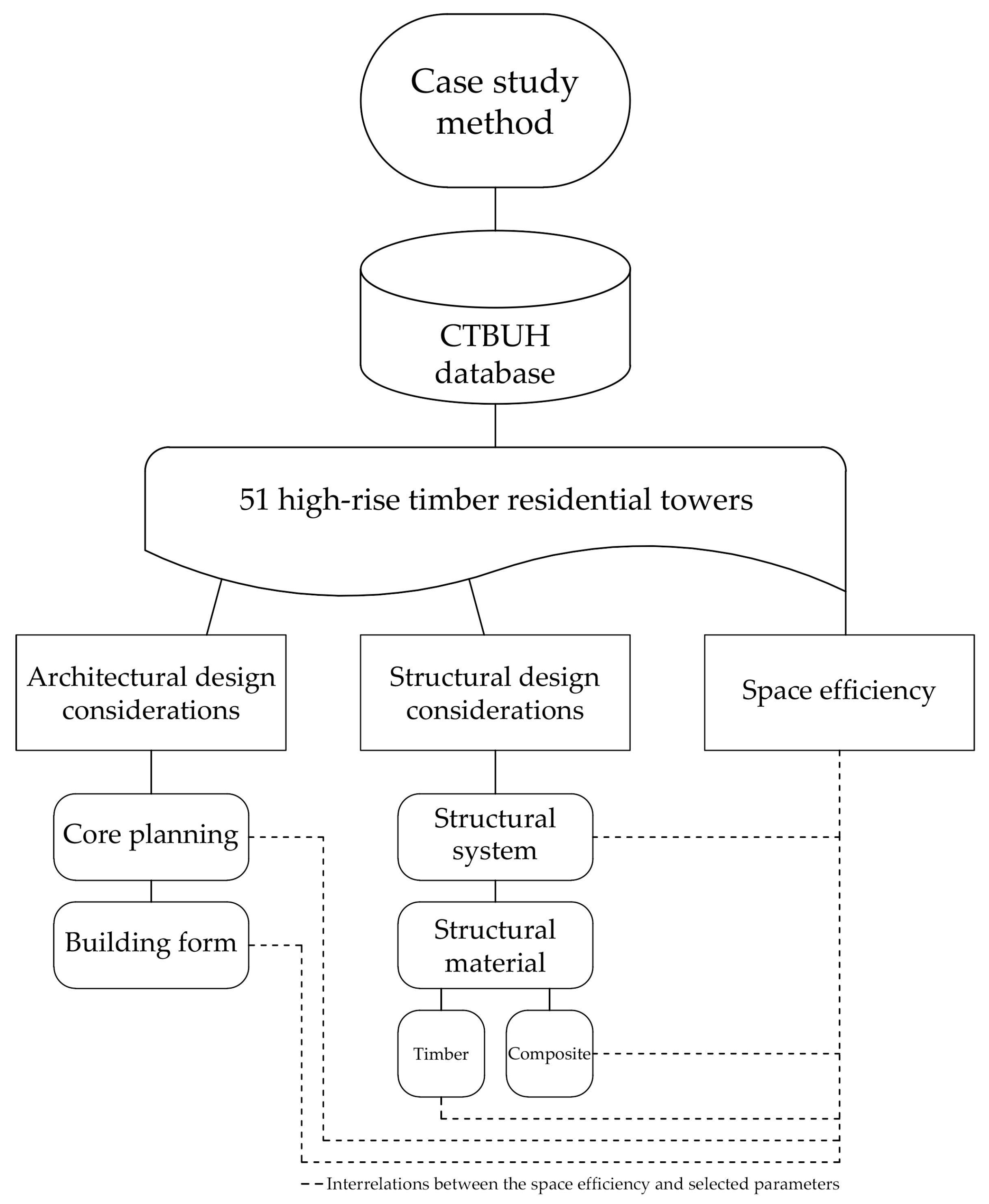
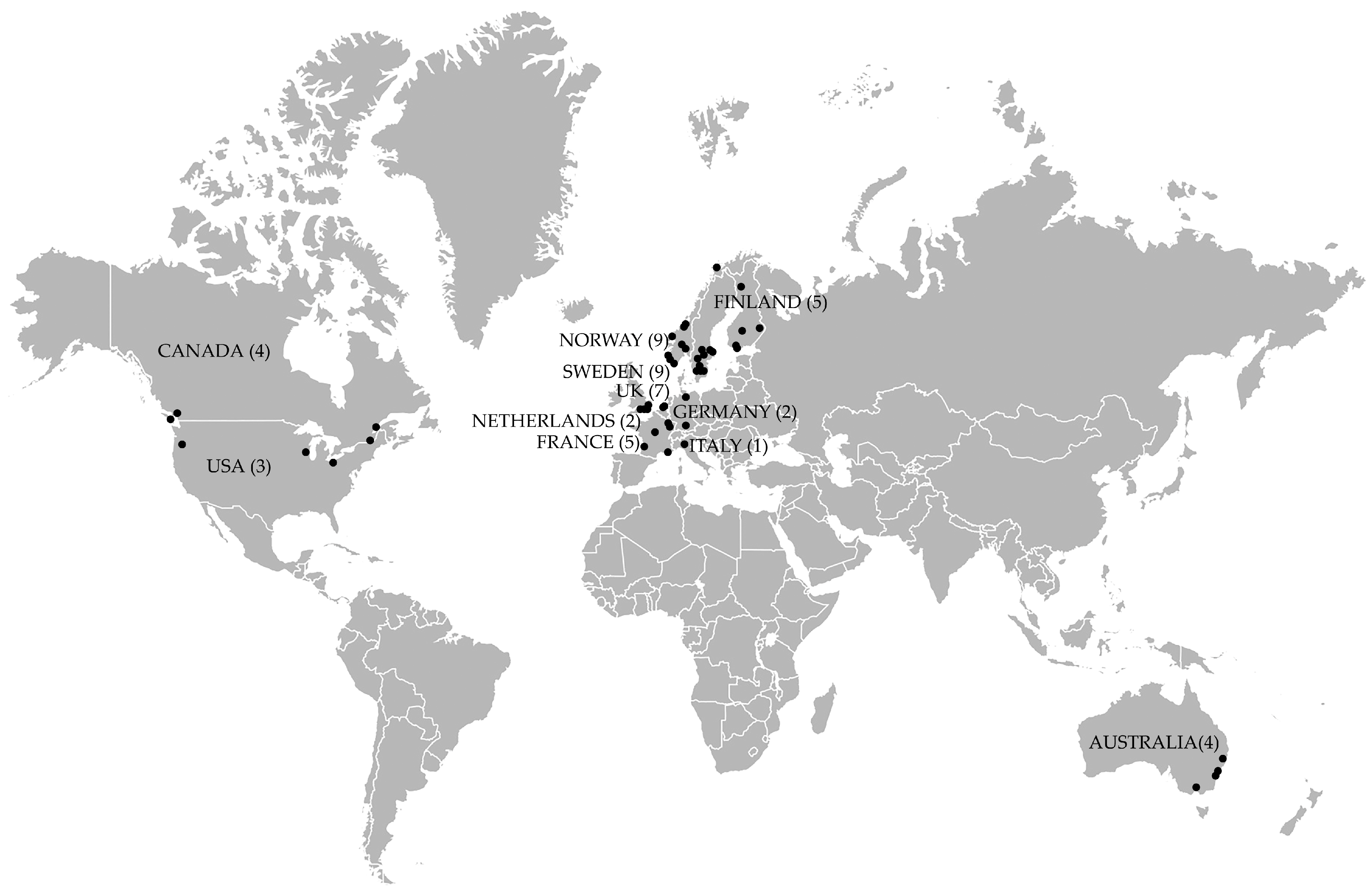
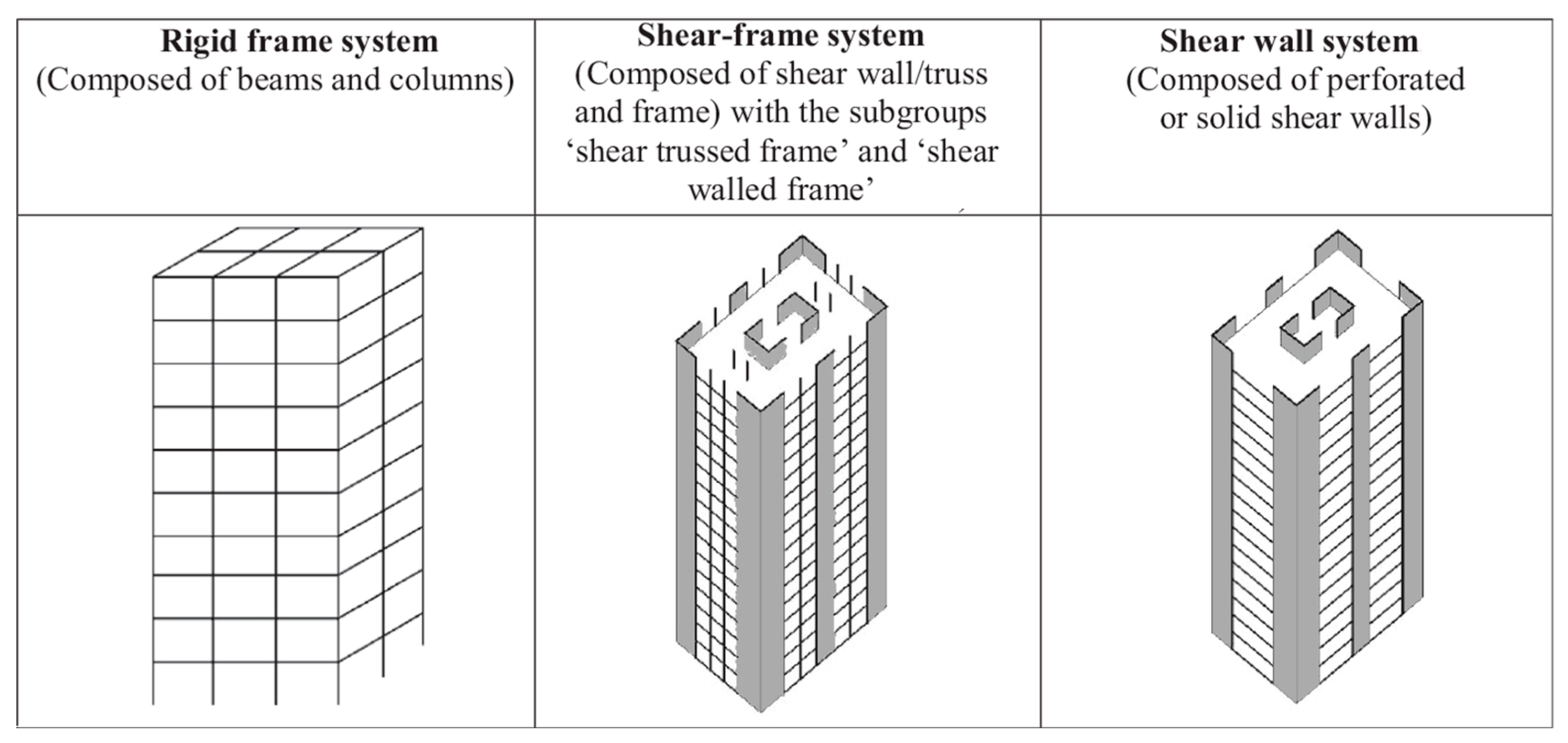

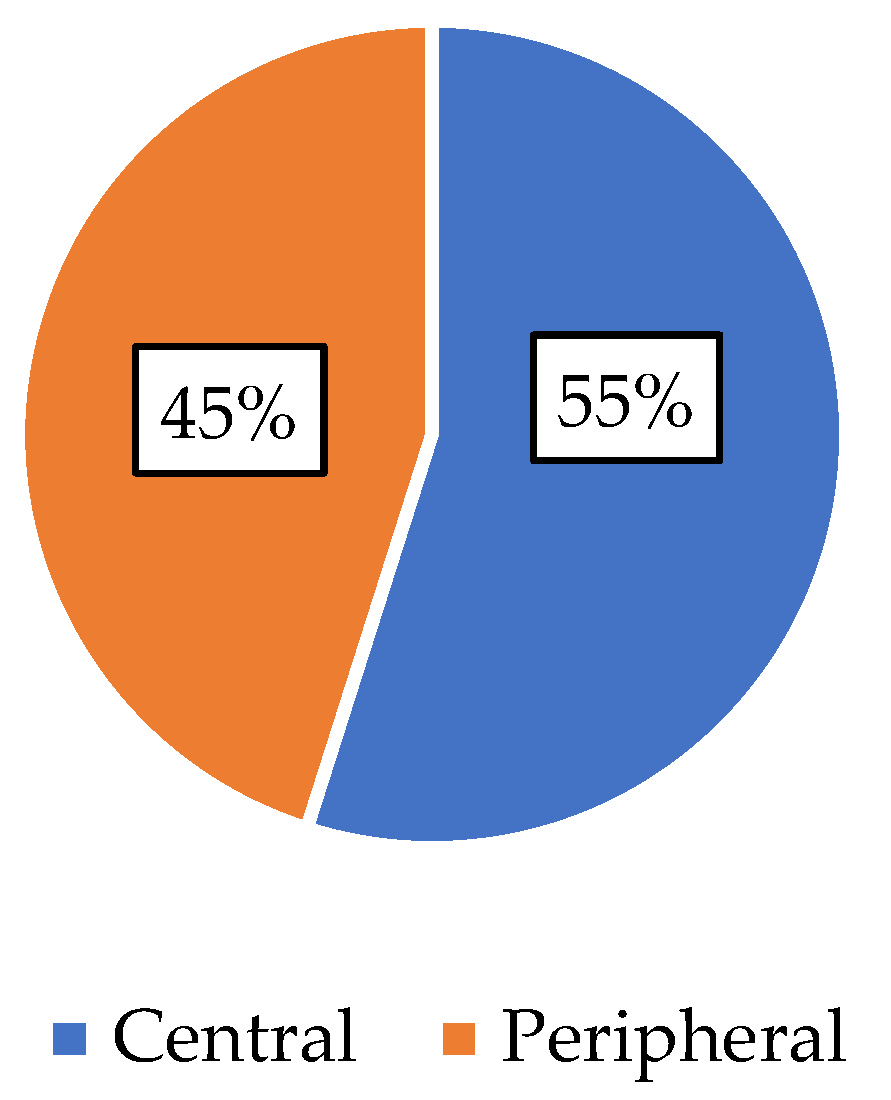


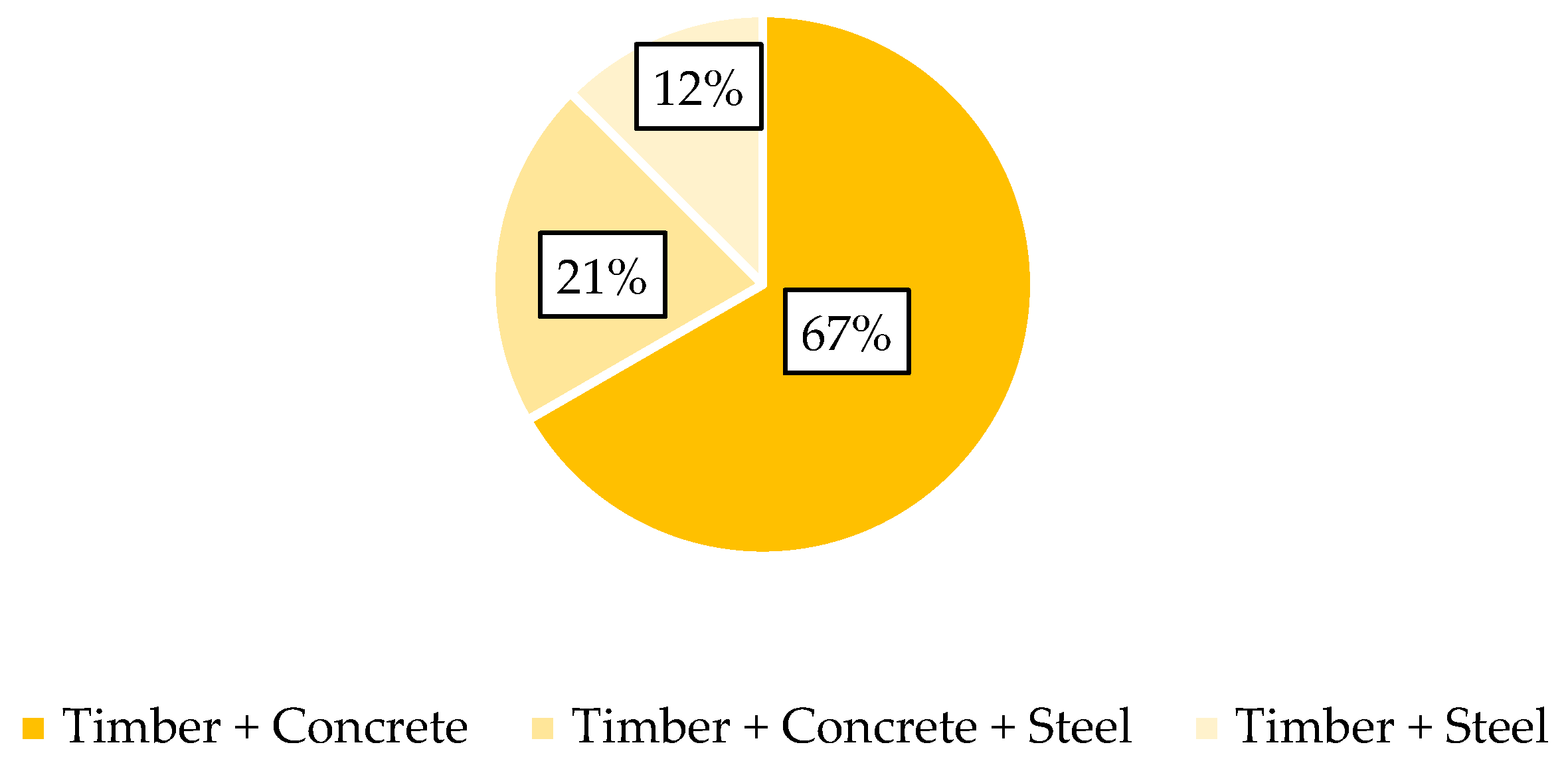
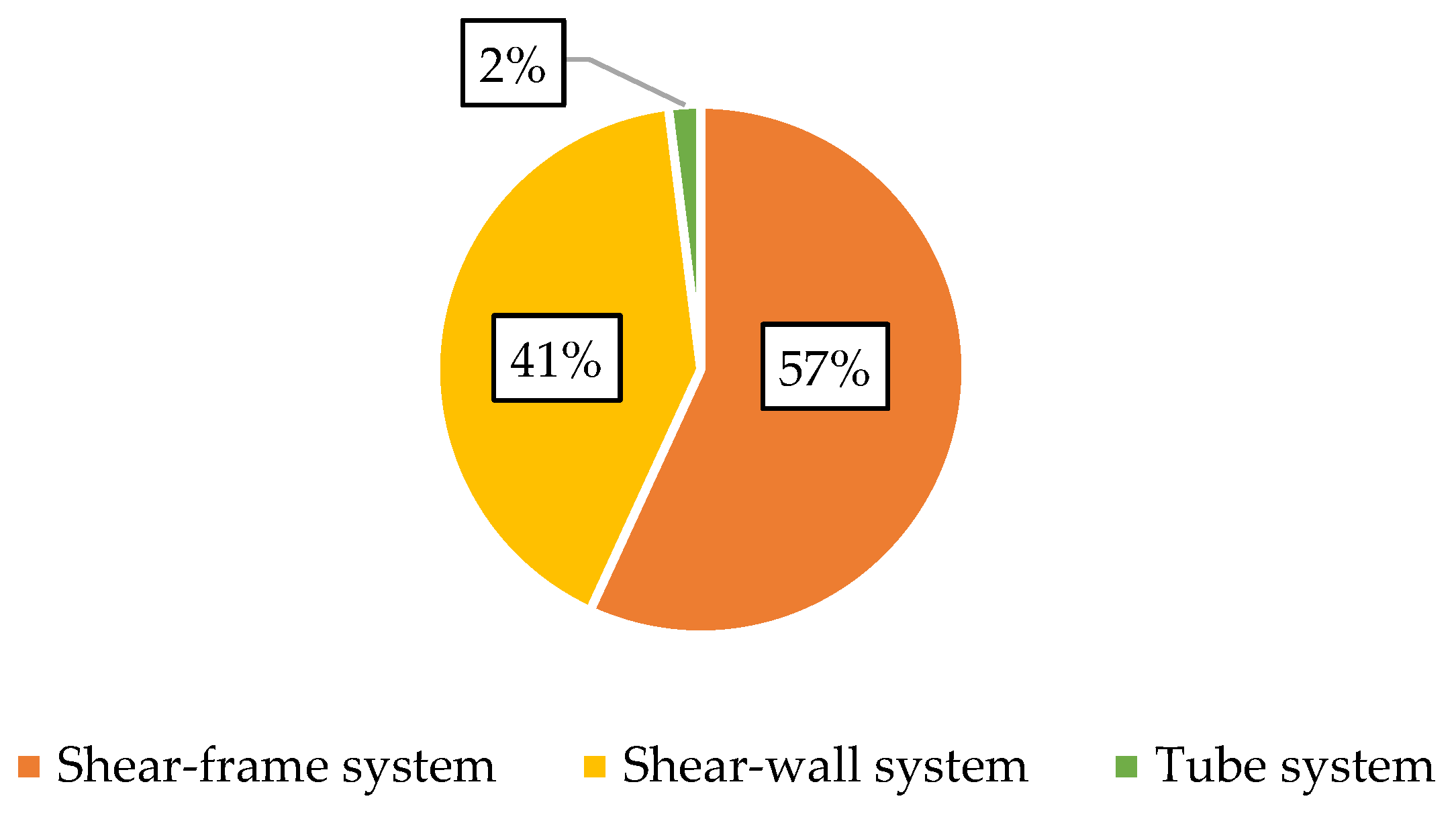
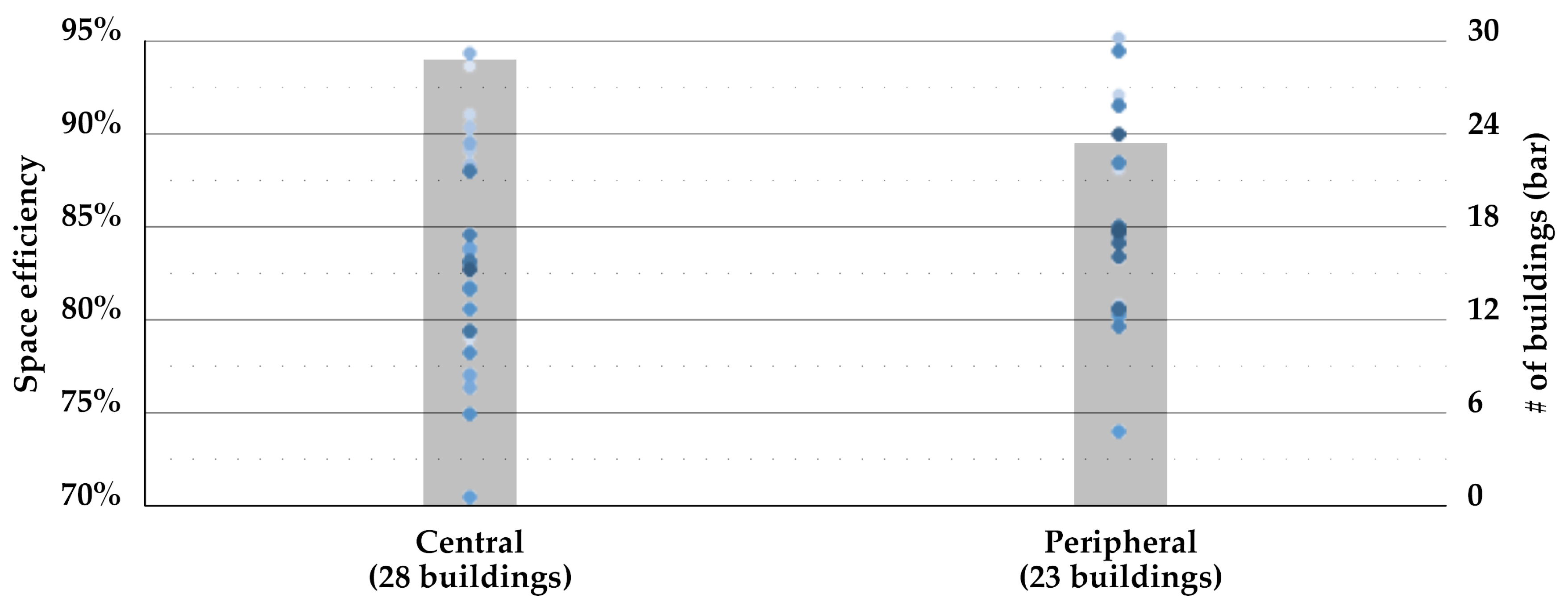
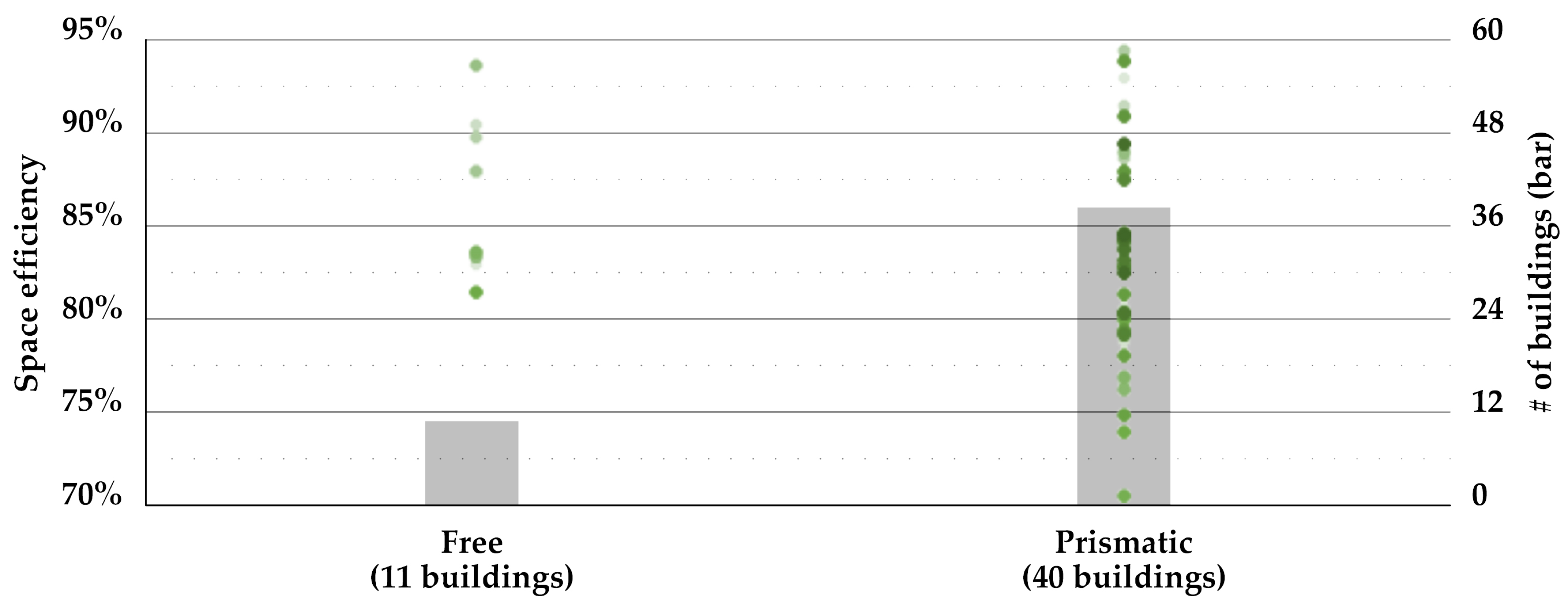
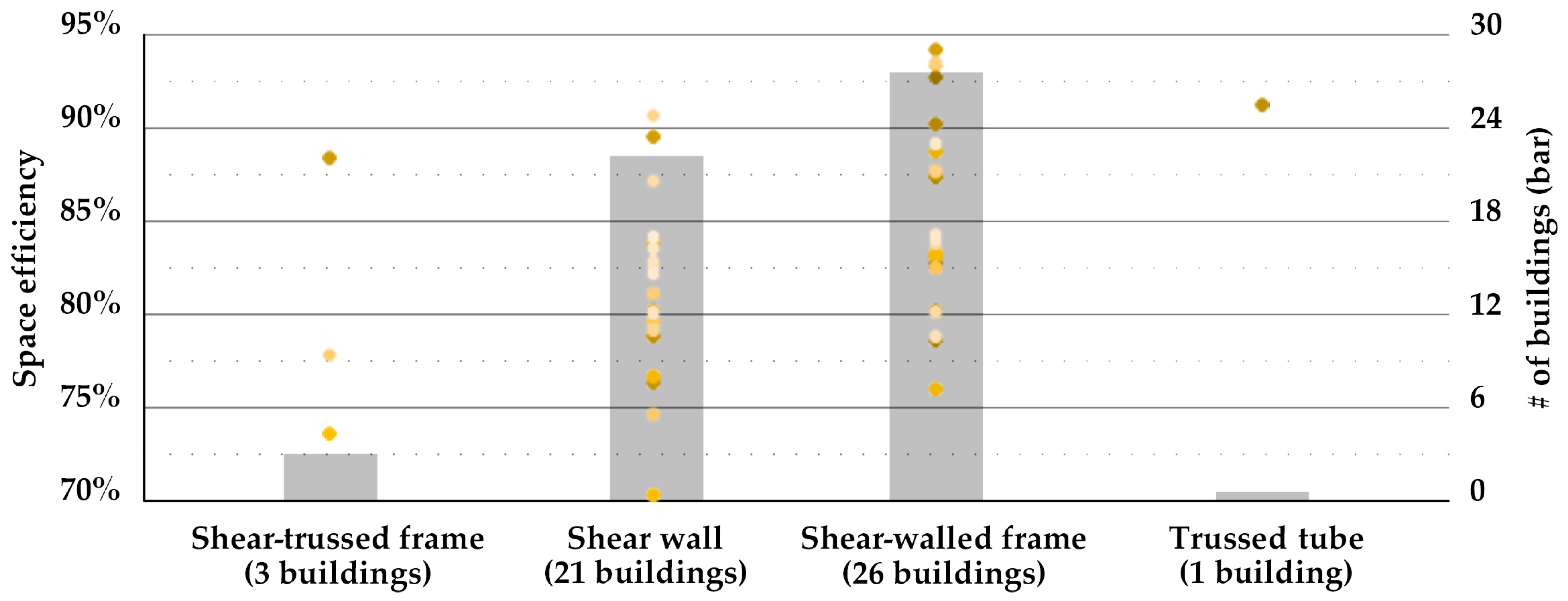
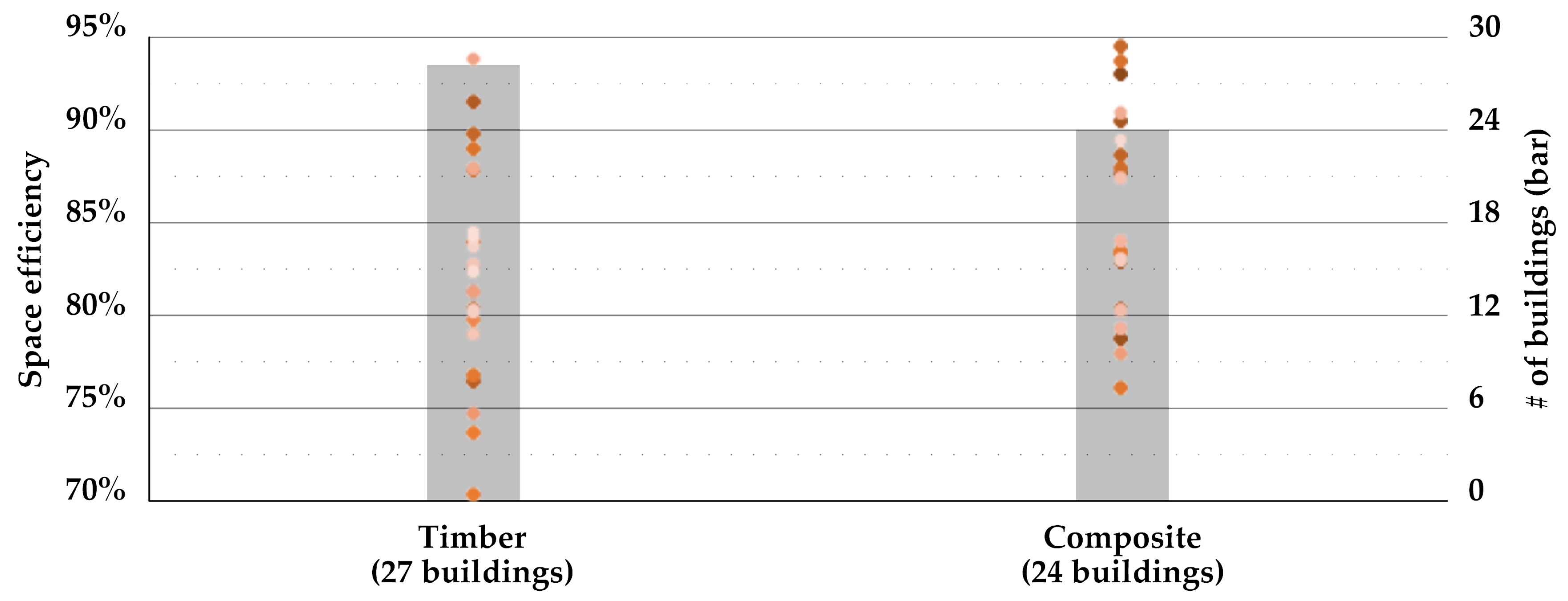
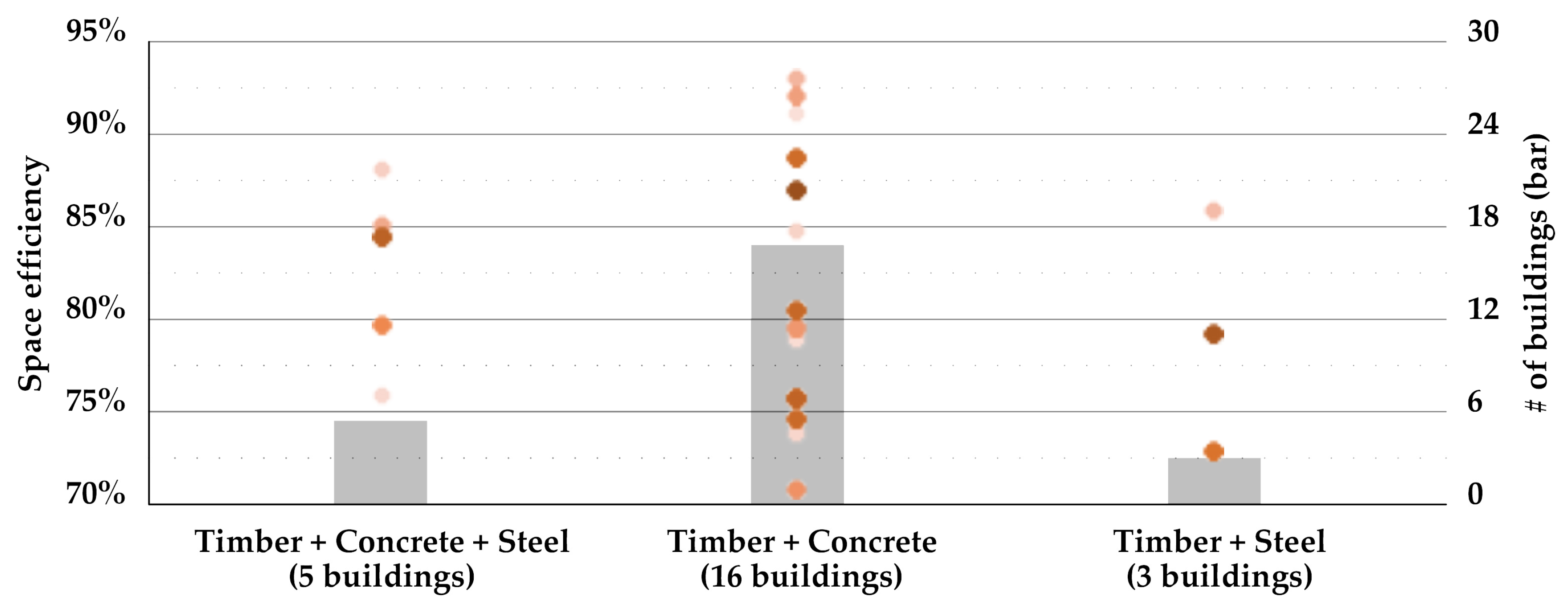
| Our Findings | Mixed-Use Skyscrapers [25] (64 Cases) | Residential Skyscrapers [26] (27 Cases) | Office Skyscrapers [27] (44 Cases) | |
|---|---|---|---|---|
| Core | Central (55%) | Central (100%) | Central (93%) | Central (95%) |
| planning | Peripheral (45%) | Peripheral (7%) | External (5%) | |
| Building form | Prismatic (78%) Free (22%) | Prismatic (17%) | Prismatic (56%) | Prismatic (21%) |
| Setback (17%) | Setback (11%) | Setback (18%) | ||
| Tapered (38%) | Tapered (11%) | Tapered (27%) | ||
| Twisted (1%) | Twisted (7%) | Twisted (2%) | ||
| Free (27%) | Free (15%) | Free (32%) |
| Our Findings | Mixed-Use Skyscrapers [25] (64 Cases) | Residential Skyscrapers [26] (27 Cases) | Office Skyscrapers [27] (44 Cases) | |
|---|---|---|---|---|
| Structural material | Timber (53%) Composite (47%) | Concrete (27%) | Concrete (96%) Composite (4%) | Concrete (14%) |
| Composite (72%) | Composite (80%) | |||
| Steel (1%) | Steel (6%) | |||
| Structural system | Shear frame (57%) Shear wall (41%) Tube (2%) | Outriggered frame (73%) | Outriggered frame (74%) Tube (22%) Buttressed core (4%) | Outriggered frame (59%) Tube (23%) Mega column & core (7%) Shear frame (11%) |
| Tube (17%) | ||||
| Buttressed core (3%) | ||||
| Mega column & core (6%) | ||||
| Shear frame (1%) |
| Our Findings | Mixed-Use Skyscrapers [25] (64 Cases) | Residential Skyscrapers [26] (27 Cases) | Office Skyscrapers [27] (44 Cases) | |
|---|---|---|---|---|
| Average space efficiency | 83% (max. 93%, min. 70%) | 71% (max. 84%, min. 55%) | 76% (max. 84%, min. 56%) | 71% (max. 82%, min. 63%) |
| Average ratio of core to GFA | 10% (max. 21%, min. 4%) | 26% (max. 38%, min. 16%) | 19% (max. 36%, min. 11%) | 26% (max. 36%, min. 15%) |
Disclaimer/Publisher’s Note: The statements, opinions and data contained in all publications are solely those of the individual author(s) and contributor(s) and not of MDPI and/or the editor(s). MDPI and/or the editor(s) disclaim responsibility for any injury to people or property resulting from any ideas, methods, instructions or products referred to in the content. |
© 2024 by the authors. Licensee MDPI, Basel, Switzerland. This article is an open access article distributed under the terms and conditions of the Creative Commons Attribution (CC BY) license (https://creativecommons.org/licenses/by/4.0/).
Share and Cite
Ilgın, H.E.; Aslantamer, Ö.N. Analysis of Space Efficiency in High-Rise Timber Residential Towers. Appl. Sci. 2024, 14, 4337. https://doi.org/10.3390/app14114337
Ilgın HE, Aslantamer ÖN. Analysis of Space Efficiency in High-Rise Timber Residential Towers. Applied Sciences. 2024; 14(11):4337. https://doi.org/10.3390/app14114337
Chicago/Turabian StyleIlgın, Hüseyin Emre, and Özlem Nur Aslantamer. 2024. "Analysis of Space Efficiency in High-Rise Timber Residential Towers" Applied Sciences 14, no. 11: 4337. https://doi.org/10.3390/app14114337





